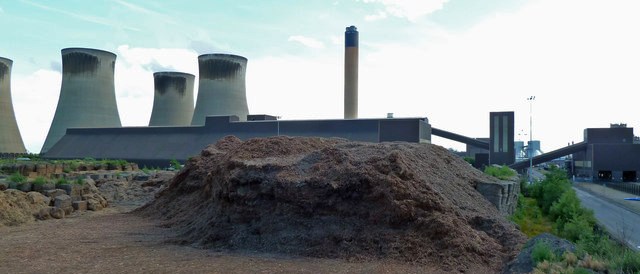In order to greenwash its coal power plants and fulfill EU requirements, Poland co-fires biomass with coal. While this is a phenomenon common in many European countries, Michał Olszewski argues that it does not make sense for the environment and helps coal companies.

Co-firing biomass – greenwashing coal? (Photo by Chris Allen, CC BY-SA 2.0)
EUR 1.7 billion – this is the amount by which the Polish government supported co-firing of coal and biomass between 2005 and 2012. What’s wrong with that, you may ask. Biomass, recognized by the European Union as an environmentally-friendly source of energy, is involved in a complex system of green certificates. Nut shells from Brazil, Indonesia and Africa, wood chips, pellets, and even full-fledged timber go to Polish furnaces and power plants in the name of environmental protection. And everything is legal, of course.
Biomass can be a great source of green energy as long as we fulfil certain conditions. Transporting these sources stemming from the other side of the world to Poland make this an ecological costly endeavour. Similarly absurd is the burning of good quality wood – although this practice was luckily blocked after protests from the furniture and paper industry in 2012. And there should be no doubts about an energy willow growing close to a biomass plant. It is always the same story: cut, prepare, burn, plant the new plantation.
The Polish example shows, however, what happens when theoretical assumptions are incorporated into practice. Biomass in Poland has predominantly been used to strengthen the country’s coal industry. Co-firing of coal and biomass appeared to be an ideal source of revenue for coal intensive energy companies. The mixing of the two materials is a great business solution – coal prices remain low, and you receive additional revenue from green certificates. And do not forget about a tangible benefit for the state as well: “sustainable” co-firing significantly improves the national statistics. By 2020, 15 percent of total energy consumption in Poland has to come from renewable energy sources (RES). The medium-term target (8.8 percent in 2010) was achieved with a vengeance, but it would never have been possible without this bizarre mix of “green” with “black”. 42 percent of renewable energy in Poland comes from co-firing, 18 percent from wind, and only 0.002 percent from photovoltaics. The 1.7 billion euros mentioned at the beginning, compared with 1.5 billion for other new RES, clearly show what form of electricity generation the Polish government has favoured in recent years.
Biomass co-firing is regulated under a new Law on Renewable Energy Sources, which was just finalised by the Ministry of Economic Affairs after years of strenuous debate. After three years of discussion, owners of large co-firing installations finally had their way: grants will still be given to large installations. The Polish Parliament will be voting on this law soon. Although criticized by energy corporations, the government proposes to distinguish between “simple” installations and more advanced “dedicated” ones (the grant will only available to the latter). This will, however, not significantly change the make-up of the energy mix. The Ministry of Economic Affairs would like to limit green certificate turnovers to small boiler units that burn only biomass (50 MW). This would probably demolish the market of large biomass installations – the world’s largest installation of this type is in Polaniec (205 MW).
Not only Poland has appetite for biomass. Throughout Europe and the United States new investments or upgrades of existing, usually coal-fired installations are underway. Sceptics suggest that the increasing demand and long distance transportation will lead to greater emissions from this material than from traditional fossil fuels.
I recently visited Copenhagen, where I listened to, inter alia, specialists from the company Hofor, which supplies the capital of Denmark with electricity and heat. The people of Copenhagen are very environmentally conscious, they ride bikes, do not like nuclear energy (yet buy it from Sweden!) nor coal (although they still use it). Hofor turned its attention to biomass when looking for more sustainable heating options. The Amager heat and power plant with a capacity of 80 MW requires 300 thousand pellets per year. Another unit with a capacity of 250 MW will be transformed for wood chips firing soon. Which means that Copenhagen will need a year at least 1 million tons of additional biomass imported from the USA, Canada and Russia.
Needless to say, it will be “sustainable” biomass.
Michał Olszewski (born 1977) – journalist, reporter, writer. For more than twelve years he worked for Gazeta Wyborcza (the most influential Polish daily) and Tygodnik Powszechny (a weekly magazine). He concentrated mostly on environmental issues (Polish climate policy, flood defence projects, waste policy). Last year he worked as a policy and media officer for ClientEarth Poland. He is engaged in a Krakow-based campaign against air pollution.
Our limited sustainable solid biomass resources should primarily to displace fossil fuels for process heat. Burning the least climate friendly renewable energy source in the most inefficient way is simply a bad idea…
Just to be clear, there is little to no biomass cofiring with coal in the US. See http://www.powermag.com/utility-biomass-use-turning-over-a-new-leaf/. It’s not competitive with wind in RPS programs, and it’s not competitive with gas as a pollution reduction measure.
Biomass is an environmental disaster in all respects. Expect a name change before 2020 as bad news starts to arrive. Drax + North Carolina, Germany + Polish forests, etc. There is a biomass plant in the middle of the Canadian forest that only burns pellets imported from Norway. Insanity.